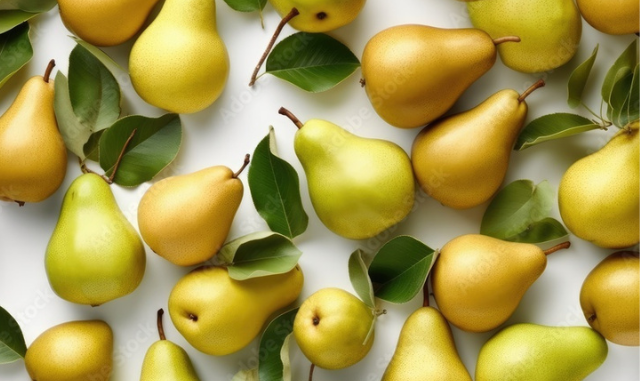
Natural Pear Health Benefits
Pear health benefits are enormous and are eaten as a rich source of folate, potassium, niacin, which supports cellular function, energy production, skin health and wound healing. Pear (genus pyrus) genus of some 20-45 trees and shrubs in the rose family (Rosaceae) including common pear (Pyrus communis) One of the most important fruit trees in the world is the common pear cultivated in all temperate zone countries in both hemispheres. The fruit is commonly eaten fresh, caned or cut into quarters to remove the core. The skin of the pear is edible and consumed as a good source of fiber. The nice way to poach pears until tender is simmered in Nunaturals Stevia Syrup flavored with vanilla bean extract topped with a dollop of low fat yogurt then sprinkled with a pinch of cinnamon. The fruit is also used to produce perry, an alcoholic beverage. Several species including the Callery pear (P.calleryana) are grown as ornamental landscape trees that offer fast growth and broad branching structure.
The common pear tree is broad headed, growing up to 43 feet high (13 meters) at maturity. The trees are typically long lived with a life expectancy of 55 to 75 years and may reach considerable size unless carefully pruned and trained. The roundish leathery leaves are wedged shaped at their base and appear at the same time as the flowers. Pear fruit is often naturally sweet, softer in texture compared to apples and is distinguished by the presence of hard cells in the flesh. The aroma of a pear is appreciated by its sweet fruity slightly tart notes. Pears have high concentrations of esters alcohols, which are of great significance to the fruit’s aroma. A pear tree begins to bear fruit when it is about 4 years old lasting over a course of 50 to 75 years in development. A 25 year old pear tree yields 1,250 to 2,250 pounds (570 to 1,020kg) of pears per year per tree.
One medium pear provides 102 calories, potassium 206 mg ,carbohydrate 27 g, Fiber 6 g, 16 g sugar. Consuming pears may support weight loss reducing a person’s risk of diabetes, heart disease and cancer when eaten with a balanced nutritious diet plan. Pears are fruit produced around the world growing on a tree until harvested in the late summer months into mild autumn. There are ten varieties of USA pears each with its own distinctive color, flavor and texture. Overlapping seasons of availability USA pears are in season nearly year round. Types of USA pears are Green Anjou, Red Anjou, Barley, Red Barlett, Bosc, Comice, Concord, Forelle, Seckel, Starkrimson pear varieties. “Pears provide a variety of nutrients necessary to lead healthy lifestyles. Pears are an excellent source of fiber with each medium sized fruit 21% daily value. Research supported by Pear Bureau Northwest indicates that fresh pear consumers had a better nutrition profile when compared with consumers who didn’t eat fresh pears.
Pear consumers ate more dietary fiber, vitamin C, copper magnesium, and potassium. Fresh pear consumers had lower intakes of added sugars, total fat, monounsaturated fats, and saturated fats. Fiber is an important preventive agent against many chronic diseases and plays a beneficial role in glucose metabolism and diabetes management. “ USA Pear Pears with red skin also contain flavonoids, carotenoids, and anthocyanins plant compounds that offer several health benefits that act as antioxidants including vitamin C, vitamin K, and copper that counter the effects of free radicals protecting cells from damage they can cause. Try some low calorie delicious nutritious recipes including pear butter similar to apple sauce, poached pears, pear pie with almond crust sprinkled with low fat cheddar cheese and hot Pear Crisp topped with almond crumble topping served with a dollop of vanilla yogurt.
Cheers!
Patricia Lynn
Images Courtesy of George at AdobeStock

Leave a Reply